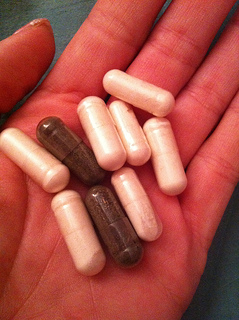Did you know about 80% percent of our immune system is located in our gut?
Our immune system is a reflection of our gut health, so it’s very important to have your belly healthy and running smoothly.
Dr. Natasha Campbell McBride, originator of the GAPS Healing Protocol, uses a wonderful analogy, comparing the digestive system to the roots of a tree.
“The root system is fundamental to the support of the well being of every single branch, twig and leaf of the tree. No matter how distant the leaf is from the root, if the roots are not healthy, it will effect the vitality of parts of the tree that are very far away. In much the same way, the health of the digestive system translates into the relative robustness or debility of all organ systems of our body, and most importantly our immune system.”
 One of the ways you can maintain a healthy gut is by taking a daily prebiotics and probiotics to enhance the proper balance of good flora into your intestines.
One of the ways you can maintain a healthy gut is by taking a daily prebiotics and probiotics to enhance the proper balance of good flora into your intestines.
The “good” bacteria found in probiotics helps to boost our immune system and protect us from infections and certain germs and viruses.
What are Pre and Probiotics?
Prebiotics are carbohydrates that, when eaten, help the growth and function of good bacteria in the gut. While the human body cannot digest prebiotics, they act as the “food” for the probiotics.
Probiotics are the actual “good” bacteria that keep your digestive system healthy. They help maintain balance in your gut by controlling the growth of harmful bacteria.
It’s important to include both pre- and probiotics in your diet, as they both play an essential role in maintaining a healthy gut and digestive system.
What are the benefits of pre and probiotics?
Pre- and probiotics can help ease a number of digestive and gut-related issues. These include:
- Constipation
- IBS
- IBD
- Diarrhea
- Bloating and gas
- Mood stabilization
- Imbalances created by antibiotics
It’s easy to add both pre- and probiotics into your diet because they can be found in supplements as well as food sources. Here are some examples of foods that include prebiotics and probiotics:
Food sources for prebiotics:
- Banana
- Garlic
- Onions
- Artichokes
- Asparagus
Food sources for probiotics:
- Sauerkraut
- Kefir and yogurt
- Kimchi
- Cultured Veggies
- Kombucha
Want a product that has both Pre-Biotics and Pro-Biotics in  one?
one?
One probiotic we recommend to our patients is Prescript Assist.
Prescript Assist is a broad-spectrum formula that provides 29 different strains of good bacteria. It is also completely stable at room temperature, which means you don’t have to keep it in the refrigerator!
Prescript Assist also has prebiotics included in it’s formula, which ensures the 29 probiotic strains have a food source when they reach the GI tract and can “repopulate” the gut with beneficial bacteria.
This particular formula also contains soil-based organisms, which are naturally hardier and able to withstand the acidic environment of the stomach. This means they are more likely to make it to the small intestine intact and colonize the gut more effectively.
